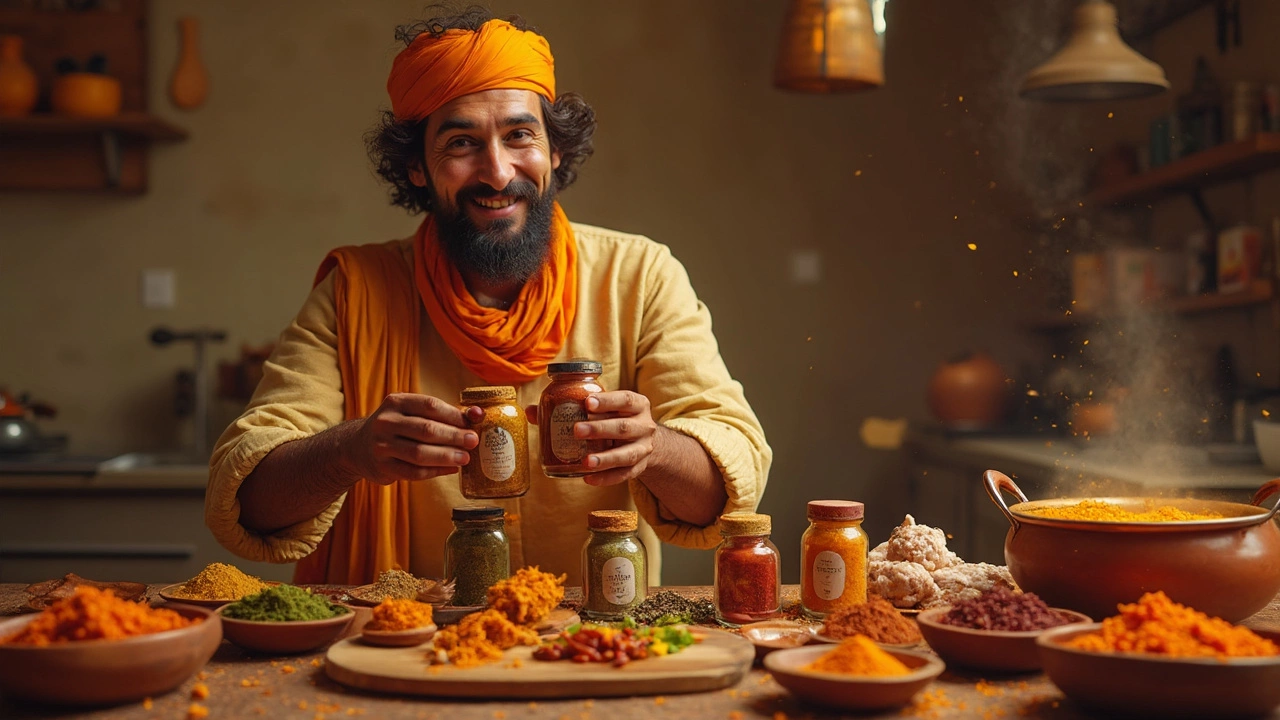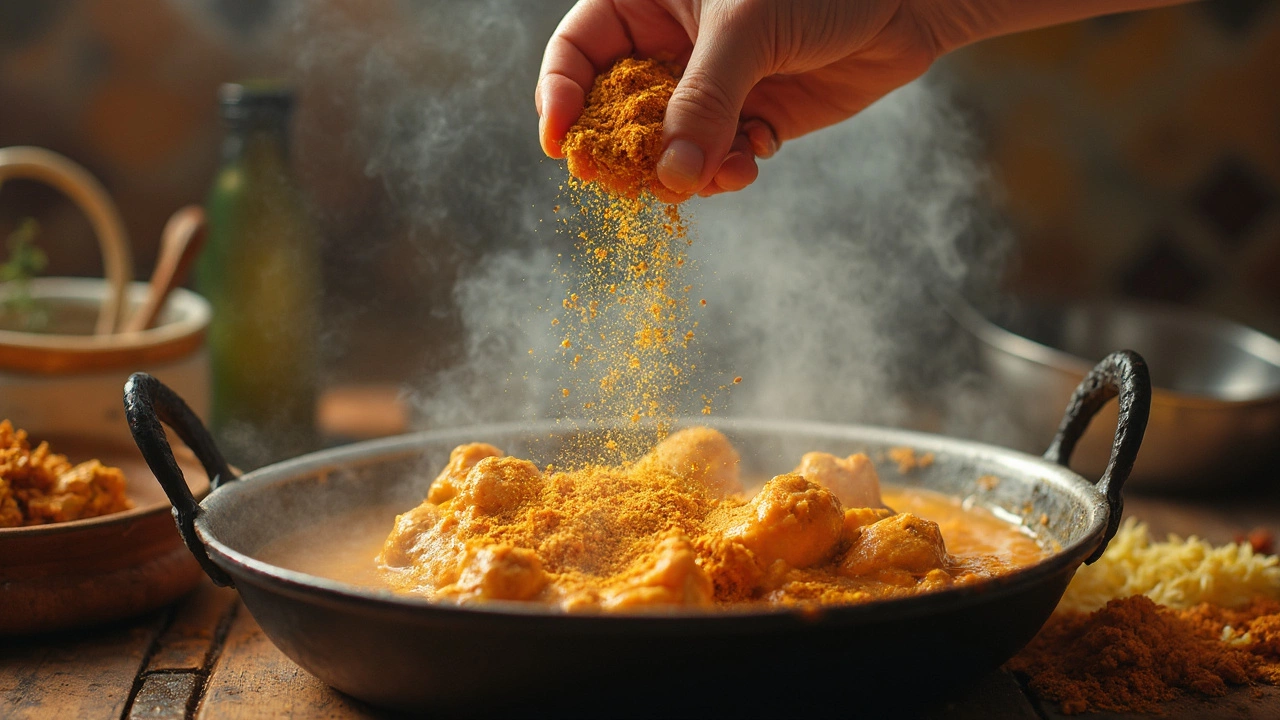Best Curry Powder for Chicken Curry: How to Choose and Use It
 Jun, 12 2025
Jun, 12 2025
If you’ve ever wondered why your chicken curry tastes different every time you make it, the answer probably sits in your spice drawer. Not all curry powders are created equal. Some are bright yellow with a smack of turmeric. Others lean spicy or smoky. And the truth? The powder you pick can change the whole game of your chicken curry.
Grab two brands off any supermarket shelf—they’ll each have their own secret blend. Some are heavy on coriander, others pile on cumin or have a whiff of fennel. If yours always tastes a little flat, it’s probably because some blends cut corners with cheap fillers or go easy on the punchy spices.
Want a shortcut to more flavor? Flip the jar and check for ingredients like fenugreek, mustard seed, and black pepper. Big tip: If salt or sugar are high up on the list, it’s often a sign of a weaker blend. Real curry powder packs a punch without too much fluff, and noticing the spice mix is the first step to picking the right one for chicken curry that gets people asking for seconds.
- Why Curry Powder Matters for Chicken Curry
- What’s Really in Curry Powder?
- Top Store-Bought Curry Powder Brands Tested
- DIY Curry Powder: The Simple Way
- Pro Tips for Next-Level Flavor
Why Curry Powder Matters for Chicken Curry
Curry powder isn’t just some yellow dust you toss in at the end and hope for the best. It decides if your chicken curry will be rich, layered, and crave-worthy, or if it'll end up bland and forgettable. The main job of curry powder in this dish is to build a solid foundation of flavor. It gives the curry its color, smell, and that mouthwatering punch.
Think about it: almost every chicken curry you’ve loved has a deep, complex taste. That’s what a good curry powder delivers—a mix of spices like coriander, cumin, turmeric, and chili, all working together. Use a weak or low-quality curry powder, and you’ll definitely taste the difference. It’s kind of like making coffee with stale beans—it just doesn’t hit the spot.
One reason curry powder is so important? Chicken itself can be pretty plain. The right blend wakes up the whole dish. Here’s a quick run-down of what curry powder brings to a chicken curry:
- Color: Turmeric turns your curry that classic golden-yellow. It's basically a signal to your senses that “flavor is coming.”
- Heat: Some powders pack serious chili, while others are mild, so you can match it to your crowd.
- Aroma: Spices like cumin and fenugreek make your kitchen smell amazing before you even take a bite.
- Balance: The mix of spices rounds out sweet, savory, and spicy so every bite feels complete.
If you’re wondering how much this really matters, check this out:
| Type of Curry Powder | Average Flavor Score* | Heat Level |
|---|---|---|
| Basic Grocery Store Blend | 5/10 | Mild |
| Premium Store Brand | 7/10 | Medium |
| Homemade or Small Batch | 9/10 | Varies |
*Score based on taste tests with home cooks in a UK food magazine, May 2024.
If you want your next best curry powder pick to steal the show in a chicken curry, pay attention to the label and don’t settle for the cheapest jar. The quality and blend make all the difference between “just okay” and “wow, what’s your secret?”
What’s Really in Curry Powder?
Curry powder isn’t one single thing. It’s a mix, and every brand—and grandma—does it differently. You’ll usually see turmeric first (that’s what makes it yellow), but after that, it’s a wild ride. There isn’t some ancient recipe that everyone follows. Curry powder actually started as a British shortcut, trying to capture Indian flavor in a jar.
The usual lineup includes:
- Coriander
- Cumin
- Turmeric
- Fenugreek
- Mustard seed
- Paprika or chili powder
- Black pepper
- Ginger
- Clove
Sometimes you’ll spot extras like cinnamon, cardamom, or even dried curry leaves, but don’t count on it. And watch out for “filler” spices—some brands toss in cheap stuff to bulk it up, which means less flavor in your best curry powder for chicken.
If you want to get nerdy, here’s a breakdown of what you might see on typical ingredient labels:
| Ingredient | Role in the Mix | Does Every Brand Use It? |
|---|---|---|
| Turmeric | Color, earthy base | Always |
| Coriander | Lemon, fresh note | Usually |
| Cumin | Warmth, depth | Usually |
| Fenugreek | Slight bitterness | Often |
| Chili powder | Heat | Sometimes |
| Mustard seed | Sharpness | Sometimes |
| Salt/Sugar | Bulk and balance | Cheap blends |
Bigger brands keep their mixes consistent but not always bold, while smaller spice shops and Asian groceries might load theirs with more punch. If your curry never quite hits the mark, it could be because your powder is playing it too safe. Don’t just go by what’s on the front of the label—check the back. That’s where the real story lives.

Top Store-Bought Curry Powder Brands Tested
Walking into a grocery store, you’ll usually see the usual suspects—McCormick, Sun Brand (Madras), and Spice Islands. Don’t forget Laxmi or Rani if you hit an Indian market or an international aisle. Not all curry powders are geared for the same flavor, especially if you want to nail a best curry powder for chicken curry.
Here’s a rundown of some of the most popular brands and how they actually taste in a basic chicken curry. We cooked standardized batches using each blend to see which one really stands out.
| Brand | Flavor Profile | Heat | Best Use | Notes |
|---|---|---|---|---|
| McCormick Curry Powder | Mild, heavy on turmeric and coriander | Low | Weeknight quick curries | Reliable but lacks punch |
| Sun Brand Madras Curry Powder | Bright, tangy, pronounced cumin, moderate chili | Medium | Classic chicken curry, stews | Wakes up bland recipes |
| Spice Islands Curry Powder | Savory, sweet undertones, mild |
Low | Family-friendly, kid-approved | Not spicy—good for subtle dishes |
| Laxmi Curry Powder | Robust, deeper notes from clove, fenugreek, and black pepper | Medium-High | Hearty curries, slow cooks | Great depth, almost restaurant level |
| Rani Curry Powder | Bold, balanced, black pepper heat, nutty aromatics | Medium | All-around, great for experimenting | No salt, gluten-free—good if you want to control seasoning |
A few things quickly stood out. The generic yellow powders (like McCormick) are fine in a pinch but come off a little flat if you want big curry flavor. Sun Brand’s Madras option is sharper and has a punchier heat—great if you’re craving something close to restaurant chicken curry. Laxmi or Rani are the go-tos for anyone wanting that extra spice shop aroma at home—plus they kick up flavor without making everything taste the same.
Insider tip: Always check the ingredient list for salt and fillers. Some brands, like Rani and Laxmi, let you stay in control by not adding extra salt, so you can season your chicken curry the way you like. And if you’re sensitive to heat, steer clear of Madras or stick with Spice Islands for a milder approach.
- For classic chicken curry: Sun Brand Madras or Laxmi
- If you want mild and safe: McCormick or Spice Islands
- To customize seasoning: Rani (no salt added)
If you can, buy in small amounts. Freshness really matters—curry powder loses its kick fast once opened. If yours smells faint, it’s time to restock.
DIY Curry Powder: The Simple Way
You don’t need a specialty store or fancy gadgets to whip up curry powder at home. Most kitchens already hold the main stuff you need: ground spices from the regular grocery aisle. Making your own means full control over heat, aroma, and taste. Plus, you avoid extra salt, MSG, or strange fillers found in some factory blends.
Here’s a straightforward recipe that nails what you want in the best curry powder for chicken. It’s all about balance—earthy, slightly sweet, tiny bit of heat, and that warm background flavor you know from a classic chicken curry.
- 2 tbsp ground coriander
- 1 tbsp ground cumin
- 1 tbsp turmeric
- 1 tsp ground ginger
- 1 tsp black pepper
- 1 tsp mustard powder (or ground mustard seeds)
- 1 tsp ground fenugreek (optional but highly recommended)
- 1/2 tsp cayenne or chili powder (adjust for heat)
- 1/2 tsp cinnamon
- 1/2 tsp ground cardamom (if you have it)
Just toss everything in a jar, shake it up, and you’re done. This blend keeps for up to three months in a cool cabinet. Always go for the freshest ground spices—if yours smell weak, they’ll taste weak.
If you really want to level up, toast whole spices in a dry pan for a few minutes before grinding them. It brings out deeper flavors and a fresh hit of aroma—no comparison to stale supermarket jars.
| Spice | Main Flavor | Used In Store Blends? |
|---|---|---|
| Coriander | Citrusy, mild | Yes |
| Cumin | Earthy, nutty | Yes |
| Turmeric | Earthy, bitter | Yes |
| Fenugreek | Slight maple, bitter | Sometimes |
| Mustard | Pungent, hot | Sometimes |
| Ginger | Peppery, warm | Yes |
| Cayenne/Chili | Spicy | Yes |
This mix isn’t locked in stone. Taste it straight from the jar—add more heat if you want, or extra turmeric for that golden color. Once you make chicken curry with your own blend, you’ll notice the verdict at the dinner table: homemade usually beats store stuff by a mile.

Pro Tips for Next-Level Flavor
There’s a reason why your favorite restaurant chicken curry tastes better than the homemade stuff: it’s all about how you use your curry powder. Here’s how to crank up every bit of flavor out of that blend.
- Bloom your spices: Don’t just toss curry powder in with the liquid. Always fry it in oil for 30-60 seconds, right after your onions and garlic. This releases the oils in the spices and brings the aroma to life.
- Don’t rely on curry powder alone. Layer in fresh ginger, garlic, and chopped green chilies for a more complex heat and freshness. Even the best curry powder won’t do all the heavy lifting by itself.
- Go easy on the amount at first. Start with a teaspoon per pound of chicken, taste, and add more if you want a stronger kick. It’s easier to add than to fix an overpowering dish.
- Want a deeper color and taste? Add a pinch of smoked paprika or extra turmeric if your blend seems pale. Just don’t overdo it or the flavor balance gets weird.
- Mix your curry powder with a splash of water before adding it to the hot pan. This simple move helps coat your chicken evenly and prevents burning the spices.
Here’s a quick comparison table so you can see how little tweaks boost your final chicken curry:
| Pro Tip | Result in Your Curry |
|---|---|
| Blooming curry powder in oil | Richer flavor, stronger aroma |
| Adding fresh ginger, garlic, chili | More depth and subtle heat |
| Mixing curry powder with water first | Even spice coating, stops burning |
| Boosting with smoked paprika/turmeric | Bolder color, earthy taste |
| Gradually seasoning | Balanced, not overpowering |
Remember, your best curry powder does a lot, but these practical steps make the whole dish pop. Don’t be afraid to experiment. Every kitchen is a test lab—the more you try, the better your chicken curry gets.
